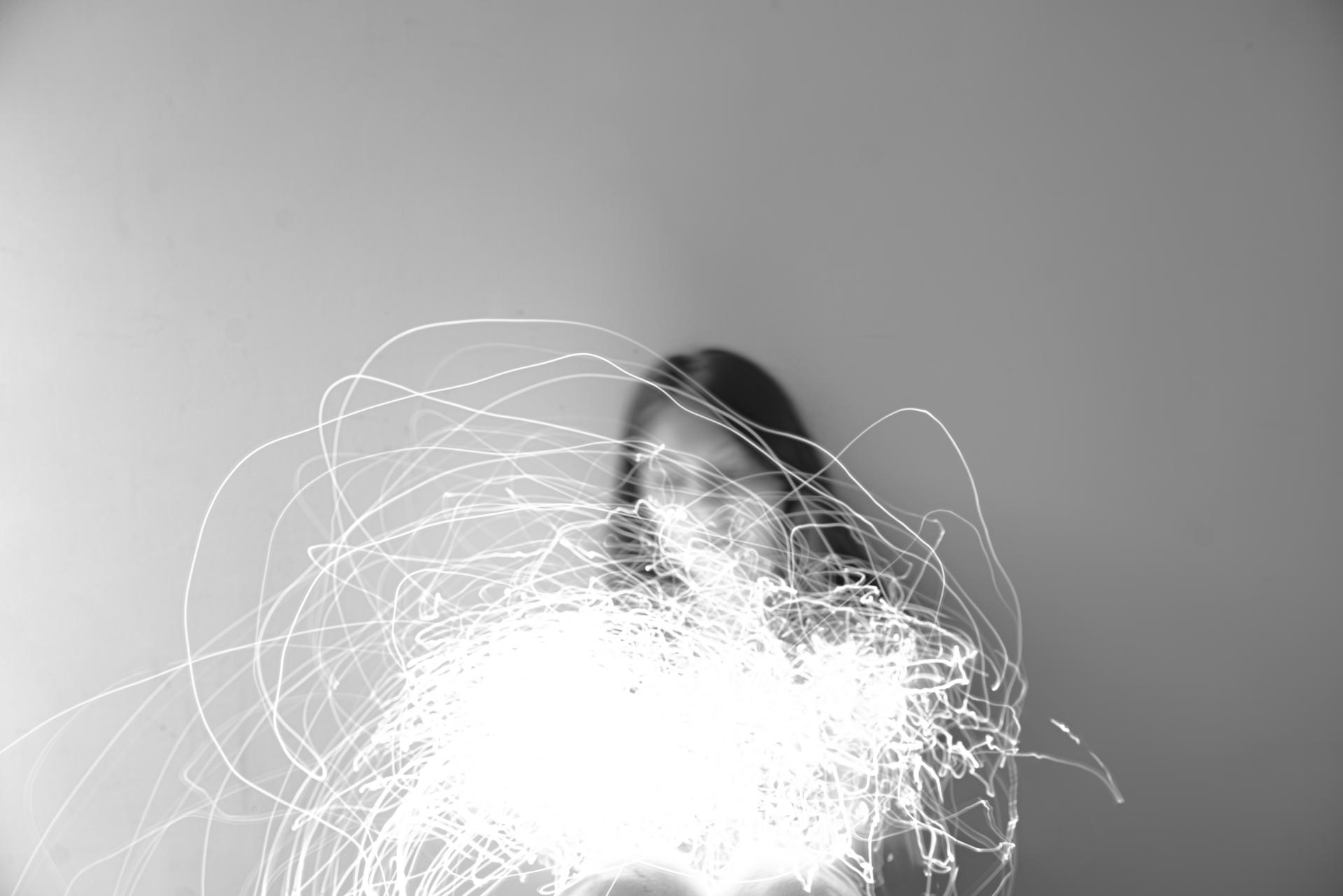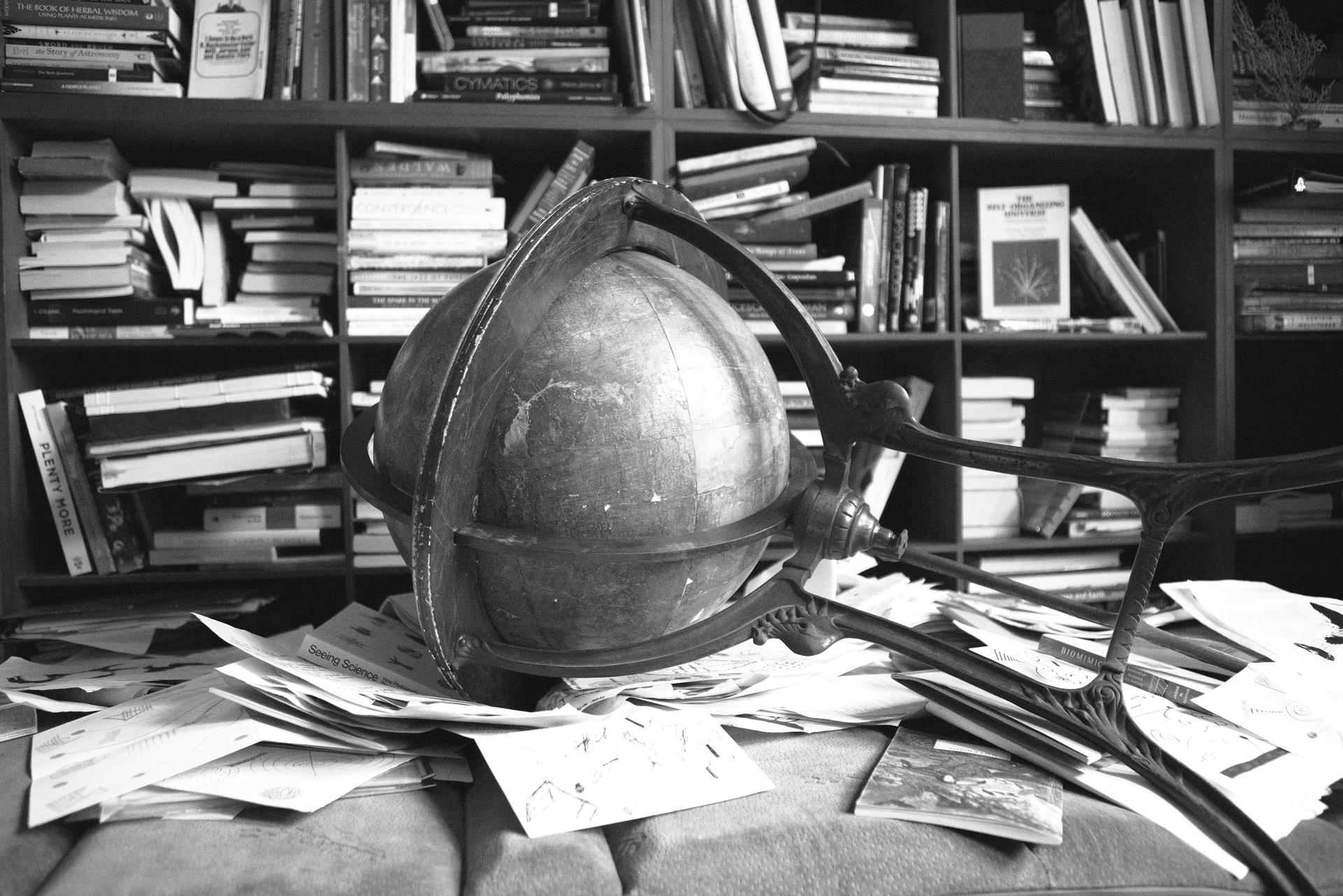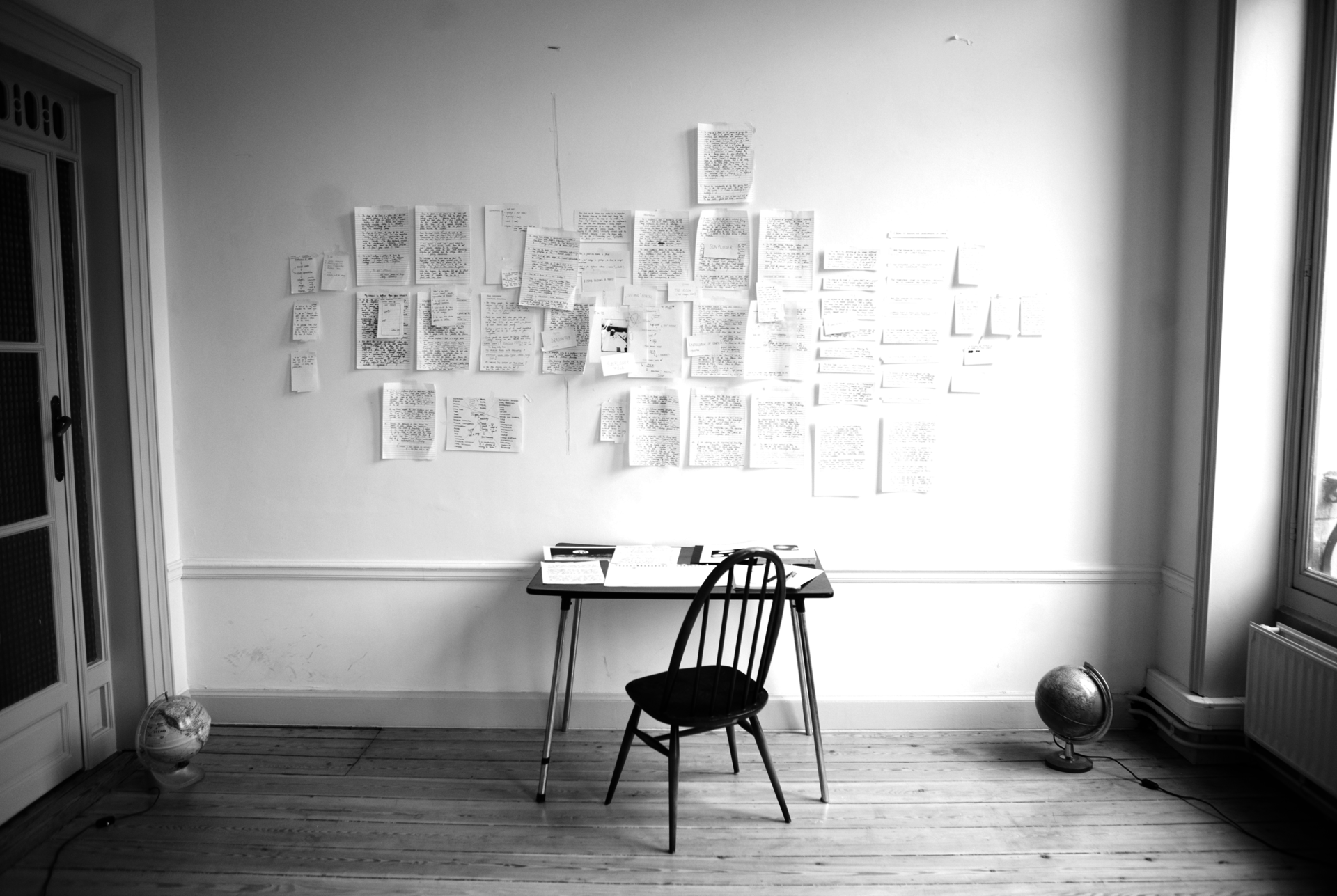I learned that the most difficult task of the writing process is to find a structure. In the beginning, the song I listened to continuously while writing was In a Landscape by John Cage. A symmetrical structure. At some point, I switched and searched for the sound of succession, of an aperiodic rhythm that transitions between order and disorder, that always returns to its origin point - an arrangement that grows and decays simultaneously, whose structure is revealed and understood only after months, years, perhaps decades of listening.
Abstract
A Pond Becomes a Forest questions the terms by which we come to our knowledge systems, and asks how we interpret and know nature. This thesis argues for direct encounters with natural forms and the processes that create them. It represents a search to understand ecology through profound attention. It proposes new ways of perceiving and interacting with the natural world.
The central character is a bibliophile who discovers a world through books. After years of immersion in words, an imaginary study room emerges, a location that represents her knowledge accumulation. After she directly encounters nature, however, her worldview changes, and she transforms into a budding ecologist. As she begins a patient process of observing natural life cycles, a new order of perception unfolds.
Through prose storytelling and empirical research, A Pond Becomes a Forest combines often disjunctive forms of writing as a method of argumentation. Unlike a more static academic paper, this thesis develops non-linearly, blooming outwards across a network of events, associations, meditations, and chance encounters. The writing gathers ideas and approaches to cultivate curiosity, capturing not only how the protagonist tends to her ecological self, but how we all might imagine doing so.
Image

The genesis of the writing process
(or how the thesis began through a series of chance encounters followed by a stream of consciousness)
It may be difficult to understand how an encounter with a seed inspired a new way of thinking. “I cannot consult my books anymore,” I told myself when I saw the sunflower seedling emerge from the soil.
I arrived in the sunflower field following the apocryphal myth of Heraclitus’ words, “Nature loves to hide.” There is more to the story. I arrived in the field because I followed the dragonfly.
My study room, where I collect knowledge of the natural world, cannot locate where nature hides, neither the books nor the terrestrial globe found at its center.
I am opposed to the shape of the globe - after all, Earth is an oblate spheroid, not a sphere. The belief that our planet’s shape is a sphere has been cultivated since the time of the ancient Greek philosophers. The concept of this shape dominated most scientific thought and mine as well.
The shape of things influences our mental structures.
My first perception of the globe was its form. Since the globe depicted Earth, I innocently assumed the Earth itself is a sphere. When I think of the moon, the shape of dew forming on the dragonfly’s eye, the shape of nectar droplets forming on the sunflower’s seed head, or the shape of a dandelion’s clock, spheres reveal themselves in my mind’s eye.
And so I wonder:
How is the formation of the moon different from the formation of dew?
How is the shape of a water droplet different from the shape of a nectar droplet?
How is the growth of seeds in a dandelion different from the growth of seeds in a sunflower?
How is the birth of a bee different from the birth of a tornado?
The answer is nowhere to be found in my ordered accumulation of knowledge. As my initial assumptions become visible, I want to understand the genesis of my beliefs. And it would be the readers’ assumption that what I wish to understand is the genesis of forms in nature.
In 1678, Isaac Newton published the “Mathematical Principles of Natural Philosophy” known as “Principia,” in which he introduced the three laws of motion and first described the idea of gravity. A peculiar fact he included was a calculation suggesting that Earth, in its revolution, takes the form of an oblate spheroid, its poles slightly flattened. In other words, he predicted that the shape of the Earth is a “nearly perfect” sphere.
If I step outside the shape of the Earth, what I perceive as a smooth surface is irregular, asymmetric—constantly changing. This leads me to believe that my perception of nature in any given instant is a conjecture. So what do I see if I step outside the shape of my knowledge system, given what I now know?
A terrestrial globe that is not Earth
A dandelion’s life cycle
A sunflower’s growth pattern
A pond becoming a forest
Image

Table of Contents
1. The construction of a room in which one accumulates knowledge occurred before arriving in the sunflower field.
2. When I started to see the sunflower seed grow
3. I began to question our understanding of Earth.
4. The terrestrial globe in the room prompted me to examine the Earth's shape
5. And the dandelion's seed reminded me to ask how we see ecology.
6. The encounter with the dragonfly led me to the sunflower field
7. And the impetus to construct a pond changed me.
8. I learned that a pond can become a forest. I cannot only consult my books anymore.
Image

Excerpts of the thesis writing; I choose paragraphs from some chapters, yet the sections are not necessarily in order as they appear in the thesis. They are selected to give the reader an idea of the project.
1. The construction of a room in which one accumulates knowledge occurred before arriving in the sunflower field
Here, in my study room, I accumulate. Unintentionally, I started to construct the room, and fittingly, the genesis of my belief began with a book. The book needed a room. The book became a pile, the pile of books became a shelf, the shelf became a bookcase. In this space, I train myself to seek an answer — in books, in objects, in piles of images, in old notebooks. If I sit still, carefully listening to a distant whirling, training my eyes on one of the corners of the room — sometimes, a connection appears. Then I leap up, search the shelf for the exact books, and pull at imaginary lines twining these authors together. These correspondences are ephemeral constructions: a combinatorial thought exercise that reveals a cloud of associations. Sometimes I am aware that in the moment of their appearance, I must also let them go. Sometimes I go too far, lost in a reverie.
Knowledge is what I accumulate. Knowledge is a continuity that happens to me, within me, and around me. In the room, I never get tired of arranging and rearranging the books like building blocks. Every progression, every new idea, makes me regroup the books. The shelves are static — layers of information upon layers of information — yet the flux of knowledge in the room is not. Before the shelves, the books would pile up on the floor, like leaves on a forest bed. The room, in short, reconfigured as a result of my interests, the categories themselves a dynamic, shifting landscape. While somewhat alluring, this dynamism often unsettles me; each configuration reveals a different subjective meaning. What is changing is not the room but my acquisition of knowledge in relation to the room. Currently, since I am yet to give a name to the topic of the research, the room is just the formation of one’s mental representation of the world, the construction of a worldview, the identification of categories, the organization of the space of knowledge. What happens to one’s perception when imagining one’s knowledge as spatial? If I had to communicate my knowledge in the shape of a room, what shape would it be? What is the room in this instant?
The room is a fixed moment in time.
The room is a diagram.
The room is constructed according to Cartesian coordinates.
The room is a clock.
The room was never an arborescent structure.
The room is no longer a sphere.
The room is the ordering of chaos.
The room could become the growth pattern of a sunflower.
The room will become a process.
The room will reveal its succession.
The room had no shape until I arrived in the sunflower field.
At this moment, the bookshelves of my study room are organized into the following categories:
1. Nature
2. Cognitive Science
3. Time and Space
4. Geometrical Curiosities
5. Fiction
In this instant, the shape of the room is no different from the shape of my thoughts - chaos, and with this chaos, the existence of broad categories. The association I have with chaos is a specific state of complete disorder, confusion, yet in my experience, chaos is the undifferentiated state, the impetus of creation, the moment just before the mind begins to form categories. I understand that a classification system is not a shape within this binary logic of order and disorder. It is a way of being. It is a way of seeing. It is a way of moving, arranging, ordering, constructing a logic of understanding. Each movement, conscious or unconscious, creates a sudden separation - it breaks the links that compose the shape of a thought, thus reconfiguring the shape of thinking. Perhaps this study room does not exist at all. What exists is the impetus that attempts to order it. The search for order is a momentum that seeks transcendence, reconstruction, unlearning and unthinking. What is the organizing principle that orders the categories of the bookshelves?
2. When I started to see the sunflower seed grow
I am in a sunflower field in downtown Providence, Rhode Island, and have just walked there from my study room. It is the beginning of June. The land rests on what used to be a highway - traces of its history can be found in the soil - the soil is compacted, low in nutrients, and toxic. The field is barren. The seeds are in their different stages of becoming - some of the sunflower seeds lie dormant; some are in the process of sprouting, some are still waiting to be planted. Each circle contains the growth of the seeds. The sight of a seedling’s emergence from the soil prompts me to comb back through my study, looking for a book that I believe can teach me how to see. I am about to begin the process of sowing. As my hands sow the first seed, I begin to interpret my experience, realizing that I cannot stop seeking knowledge. I return to the bookshelves in the study room and ask, “In what category is this knowledge that I am seeking?
Between my study room and the sunflower field — “between two moments in time, between two points in space, between two worldviews, between two states of knowledge” is the image of a hand in the process of placing a seed into the soil and the image of a hand turning the pages of a book. By placing the seed into the ground, I’m launched into inquiry: How, after all, does a seed become a plant? What is the difference between a sunflower and a book about sunflowers? What can a seed teach me that a book could not? In any event, within each encounter, I return to the room to seek an answer. My mind wanders through its labyrinthine hallways, eager to descend into the origin of things and ascend towards understanding. I am looking for a book.
In the moment of perception, it wasn’t necessarily a book I was trying to locate, as much as a phrase, an image, a word or configuration of words, an association that could guide me towards identifying a category in which I could place the encounter with the sunflower seed in order to make sense of it. Meaning emerges in relation to something else, there are no discrete shelves. Yet, I see all the accumulated knowledge as discrete, as mentioned in Aby Warburg’s Mnemosyne Atlas, as juxtaposed images contained into a point, as thematic polarities following an intuitive logic. The perceiver enters a space of contemplation where the relationships between the different images reveal cultural conflicts, discrepancies, and similarities. I see all the books in the room as images, aligned like categories in an unformed classification system. This classification system is lying somewhere between imagination, instinct, and memory. It is not static. It appears in more than one category, revealing its distortion, relativity, simultaneity, and evolution.
First, I see the seed, and then I try to read it. I try to read the seed as if it is a book. When I am reading, I interpret the author’s written words through my memory, weaving past experiences and my emotional self with the text before me. The seed challenges me to be present, to realize that I do not have any knowledge of its unfolding, its future, its world. To see and to read are synonymous, yet the seed is not a book. I do know how to see through my eyes, yet I do not know how to read. To perceive with the eye is to form a mental picture, to interpret as if by reading. What is the connection between “knowing,” “seeing,” and “perceiving?” How does seeing translate into perception? How does perception become knowledge in the mind of the observer?
The image of a hand sowing a seed is a gesture of reciprocity, uncertainty, and collaboration with processes that unfold, become, transform, and interact. The image of a hand turning the pages of a book is a movement towards knowing. Goethe once advised the observers of nature to pay attention to the transition from seeing to interpretation; He warned against the human mind’s tendency to impose an intellectual structure that is not present in the thing itself. Being aware of Goethe’s warning, I do not know what intellectual structure to impose on the sunflower’s life-cycle. My goal is to achieve a metamorphosis of perception.
Through books, I become vulnerable to many different intellectual structures, other people's crystallized knowledge. Reading a book is an interaction between a reader and a book,between the mind of the reader and the mind of the author. What the author is precisely arguing does not concern me as much as interacting with the written words, allowing my imagination to take over. When I read books, I become a detector of undercurrents, similar to the current of water just below the surface, moving in a different direction from the surface current. I detect the same pattern in the act of "seeing" or "reading" the sunflower seed. I want my subjective self to interpret it, but I become aware of my interest in scientific knowledge. Scientific certainty takes over, and I start doubting my interpretation. I stop seeking the undercurrent, the movement against obvious appearance, the movement underneath the surface. It represents the insight that can only be gained through deep and prolonged attention. It is the moment when knowing becomes tacit, the most important moment.
A life-giving seed is a seedling and will become a seedling, then a stem, a bud, and finally, out of the bud, more seeds. Growth and decay, continuously. My description is an over-simplification; words cannot contain the complexity of a life cycle. My description is distorted because my understanding of what a sunflower is depends on pre-existing knowledge. At first sight, the transition from seed to the flower in bloom remains unknown to a temporary observer like me. The transition between the different stages of development can only become known through direct experience, unfolding over time. I do not have the language to describe what I am perceiving, nor a system of reference. As humans, we are not necessarily born with this knowledge — we acquire it. How, then, does one acquire knowledge of Earth, its life-forms, processes, and interactions? Perhaps what I am seeking is not nature but the language that can describe my sensuous experience.
From the Encyclopedia Britannica, I learn about the sunflower’s genus; why and how it is cultivated; a brief description of its stem and leaves; I understand that its disk flowers are“valuable from an economic as well as from an ornamental point of view”; the fact that its leaves are used to feed domesticated livestock or that out of its flowers one can produce a yellow dye. I learned about the sunflower oil, which is comparable to olive or almond oil, can be used to produce soaps, paints, or as a lubricant. Lastly, I realize that the seeds are used in bird feed mixes and can be eaten in three distinct ways: dried, roasted, or as a butter. Sunflowers are being portrayed as commodities. There is no ecology, only utility. Our perception did not evolve to access the relational and developmental information embedded in the forms of nature directly. The logic of their knowledge is preventing it from being known at first sight. What at first sight is perceived depends on the subjective world of the observer and cultural background. I believe that culturally, we are predisposed to only certain types of knowledge focused on consumption and utilitarian purposes and we need to shift.
4. The terrestrial globe in the room prompted me to examine the Earth's shape
In my room, I see the terrestrial globe as Earth, yet I sense it is more than a static sphere. Questions shift, like tectonic plates, beneath a smooth surface: How does this globe influence my perception of ecology, nature, Earth? Looking at the globe, I recognize that the sphere is a structure of thought, a morsel of meaning constitutive of reality. The significance of this form only becomes clear when you pay attention with intentionality — when you acknowledge it. You enter a web of pre-existing associations and meanings, and in finally learning to “see” this web and discern its components, we can trace this knowledge back to its origins, to the moment we first recognized the Earth is not a terrestrial globe. What is the origin of the terrestrial globe, and why the first instinct was to give it a cartographic function?
The intuitive distinction is that Earth as a planet emerged, while globes are designed. Planets are born from the giant, donut-shaped disk of gas and dust that circles young stars. Globes are designed from human-made materials — Papier-mâché, wood, metal, composites, resins. Earth formed itself very differently than traditional cartographic globes that mark out land and sea along the lines of latitude and longitude or the celestial globes that map the sky. The shape of the Earth is bumpy, irregular, and constantly changing. The shape and the surface of the globe are not. Looking at the shape of a planet and thinking of its formation process requires a mental shift that is very different from having an aesthetic or emotional experience of the 'thing' that one perceives. What shapes our perception assigns to Earth matters. It matters because the shape of the Earth is dynamic, not static. The Earth is an irregularly shaped ellipsoid. The science studying Earth's shape is called 'Geodesy,' and it deals with its measurement and representation. Through geodesy, one can calculate the rough size and shape of the Earth:
While the Earth appears to be round when viewed from the vantage point of space, it is actually closer to an ellipsoid. However, even an ellipsoid does not adequately describe the Earth’s unique and ever-changing shape. The shape of the Earth is always changing. Sometimes this change is periodic, as is the case with daily tides that affect both the ocean and the crust; sometimes the change is slow and steady, as with the drift of tectonic plates or the rebound of the crust after a heavy sheet of ice has melted; and sometimes the shape of the planet changes in violent, episodic ways during events such as earthquakes, volcanic eruptions, or meteor strikes.
7. And the impetus to construct a pond changed me
I intended to interact with the soil, to observe over long periods the behavior of the dragonflies and other species, to listen to the land without imposing myself on it, and to acquire knowledge through direct interaction. Each time I wanted to begin this pond, however, I hesitated. I felt an instinct to do it, yet… I couldn’t start. It was as if, unconsciously, I resisted building in this space.
The pond was decidedly unlike the room where I keep my books. I could not “read” its inlets or tributaries. In short, I had to construct not categories, concepts, or ideas but an actual ecological body. Ironically, I tried to frame this blockage in terms of the room: I wondered what pre-existing knowledge kept me from starting. Perhaps it was this attempt to engage in the same knowledge and material systems that I wanted to move away from that made it impossible to do so. I did not want to become what I was criticizing. I did not want to see systematically; I wanted to see ecologically. To understand my hesitancy, and perhaps paradoxically, I once again turned to books.
Without any intuition of the soil, heedlessly constructing my pond would simply reproduce the same conditions that I critiqued. Perhaps, this latent knowledge—a sort of guilty conscience—stayed in my hand. Perhaps unconsciously, I wanted to build the pond to see ecology unfold, to think outside my room. In the process, I found different challenges and a confrontation with the limitations of my own perception.
8. I learned that a pond can become a forest. I cannot only consult my books anymore.
The dynamic shape of the Earth, the sunflower’s life cycle, the life cycle of the dandelion, the pond, and its succession — nothing in nature is static. The room, however, is a static representation of knowledge. The creation of the room was necessary to identify one’s acquisition of knowledge. The goal is not to understand these things fully but to be comfortable in not knowing and to be aware of the shortcomings of the models that we build our understanding upon. After understanding a glimpse into how the human mind acquires knowledge and creates categories, I know that constructing a pond is very different from building a room - the pond is dynamic, successive, and has an entirely different logic than any of the books in the room. The pond is a process. The room is static. And meaning is a process. As urban citizens, we may not acknowledge the evolution of a landscape because we are temporary, passive observers. The thought of a pond becoming a forest represents a shift in perception from static to ever-evolving. To see ecology requires long-term thinking. The time spent in the sunflower field inspired me to question what I thought I knew about the human-nature interaction and to seek an epistemological argument about how we acquire knowledge of life-forms. In an age where we are disconnected from the ecology of a place that operates at entirely different time scales than us, what can we do to enhance the survival of natural spaces in cities? Perhaps, the impetus of constructing a pond in an urban setting is a window into learning viscerally about wildlife habitats in urban environments. The pond becomes a way of articulating a phenomenology of habitat-making and the creation of ecological awareness. As a result of my questioning, I underwent a series of conceptual shifts in my understanding of what knowledge is and how it is communicated.
One form of knowledge becomes the origin of all others again and again. Where does nature hide — from one level of understanding to the other. The natural world is concealed in form, surfaces, currents, simultaneity, interaction, coordination, feedback loops, strange attractors, movement, nodes, self-organization, relativity, and reciprocity "and .... and … and .... ." In the "and" is where nature hides.
The quest for the organizing principle that orders the categories of the bookshelves became the quest for the organizing principle that orders the categories of the pond. I shifted from having to place things into categories (the room) to asking questions, open to whatever there is to find, without a need for answers or organizing. The organizing principle of the pond is not mine to know. It is pond knowledge, and I can situate myself within this environment, a member of the community of the pond and the ecology surrounding it. Accumulating knowledge is both simultaneously an act of learning and unlearning. Accumulating knowledge has been my way of finding my attunement to the flow of the world surrounding me and by releasing myself from a need for answers, I instead seek to meet the world and its inhabitants right where they are at, but also where I am at, from my subjective vantage point as a human.
The difference between a sunflower and a book about sunflowers is the transition from human-centered knowledge to local ecological knowledge. Now, I no longer depend on the room to seek answers. The world has ceased to be a binary of questions that have a stable answer. Now, the world is a question whose answer is a process, a continuity I am tuned to. The metamorphosis of perception is not a goal but a way of continuously transitioning between order and disorder, between scientific understanding, intuition, and knowledge gained from the ecology of place. A transformation indeed happened, and this transformation can be found in the balance created between the question “how can this be used?” and “how can this be met without pre-existing motives?” In perceiving all life-forms as interconnected, instead of exploitable resources. I want to see the unfoldment of life cycles of all I encounter in any given instant. And this is what I’ve learned. The gradual acquisition of knowledge and conceptual change over the summer led me to dream that a pond can become a forest. I am learning to describe what I am perceiving, but not by name. To describe what I am perceiving by imagining its life-cycle, projecting, anticipating its becoming, seeing through meaning, and knowing that beyond the physical appearance, there is succession, growth, and decay.
The construction of a room in which one accumulates knowledge occurred before arriving in the sunflower field. When I started to see the sunflower seed grow, I began to question our understanding of Earth. The terrestrial globe in the room prompted me to examine the Earth’s shape and surface and ask how we see ecology. The encounter with the dragonfly led me to the sunflower field and the attempt to construct a pond changed me. I learned that a pond could become a forest. I cannot only consult my books anymore.
Image

Image

Writing at Alba: The House of Shared Talents artist residency in Charleroi, Belgium May 2021
Image

A brief note on the writing and visual process
The photography included in this work emerged from a force within my subconscious that I began to understand and articulate only through writing. Throughout the process, I thought I struggled to create imagery that could communicate my writing, only to realize at the end that the images were there from the beginning and had always been there to guide me.
My perception of the terrestrial globe shifted in two years, from an object that activated a sense of wonder and discovery, to discovering its cartographic function, and finally understanding its place in the history of colonialism. I only understood my impetus to create those photographs and my movements around the terrestrial globe that transmuted my understanding as I began to read and engage with the existing literature on the topic.
The thesis has many starting points that I struggled to weave together, as they are juxtaposed and simultaneous in my mind. A predominant theme in my process was the question of which moment shall I begin the thesis with?
I searched for a structure by drawing inspiration from the writers Jorge Luis Borges, Italo Calvino, and Clarice Lispector. It was towards the end of the writing process that I found the book Chaos and Order: Complex Dynamics in Literature and Science by literary critic and professor N. Katherine Hayles which shifted my perception of what a structure in literature could be and understood why I was drawn to the writers I chose as my inspiration. For example, I learned that Jorge Luis Borges predicted the bifurcation theory in his short story The Garden of Forking Paths before mathematicians, constructing a plot with infinite diverging narratives. It is a beautiful example of how art and science are also present in literature. How Borges Wrote, written by author Daniel Balderston was also very insightful as an entry into the mind of a writer that constructed such complicated structural narratives, and Thinking Space by the poet and essayist Lisa Robertson allowed me to reflect on the spatial organization of knowledge in the form of a research room.
The short essay "The Analytical Language of John Wilkins" by Borges was a starting point as he proposes a new way of thinking about how we order knowledge in categories. Borges' conclusion is that "there is no description of the universe that isn't arbitrary and conjectural for a simple reason: we don't know what the universe is." Such is the case for our category of "nature."
From the beginning, I wanted the abstract to tell the story of the thesis while also representing the thesis's ending and to show the transformation of a bibliophile to a budding ecologist, the difference between constructing a room of knowledge ordered in specific categories and constructing a pond as a reconstruction of the self. This idea stuck with me from reading If On A Winter's Night: A Traveller by Italo Calvino, where he plays with a similar concept that is revealed only at the end, leaving his reader throughout the piece in confusion, only to resolve the tension at the end. Although my intention is not to create confusion, the reader is required indirectly to follow a different reading pathway. This pathway can only become known by stitching the pieces together incrementally and non-linearly. It asks the reader to let go of conventional ways of reading a novel and perceiving a structure. I have yet to find the technique through which I will tell the story of succession, of how a pond can become a forest through its structural narrative. Nevertheless, I am fascinated by the possibilities of storytelling, of imagination, of becoming.
